Desert Invasion - U.S.
Article
The Henry and Kathy Harvey Story,
Cochise County, Arizona
By Linda Muller for Team America
www.TeamAmericaPac.org
May 17, 2004. (Reprinted with permission).
http://www.teamamericapac.org/ta-nw-040517-harvey.shtml
Recently I received an email from Henry Harvey and his wife, Kathy. He wanted to know if we were interested in receiving some pictures of the illegal invasion in Cochise County, Arizona.
Over several days through email and phone conversations, I learned how the Harvey's try to help stem the flow of illegal aliens. This is their story as they attempt to live a normal life -- on our southern border.
LM:
Henry, I would like to see the photos you mentioned. I plan to include them on our website along with an interview, if that's possible.
Henry:
I have lots more pictures which I will send. Some are unbelievable trash and litter sites, others are encounters we have had with illegal aliens.
We live in one of the most heavily trafficked corridors in the nation for illegal aliens stealing across the border. We have been trying to do what we can on the ground to fill the gap the Federal Government has refused to do.
My neighbors and I are grateful when we can find a voice that is interested in our problem and will present it to the American people.
Congressman Tom Tancredo has been down here many times to see our problems first hand and has been very sympathetic and supportive of our situation. We appreciate any assistance in this matter that you can give.
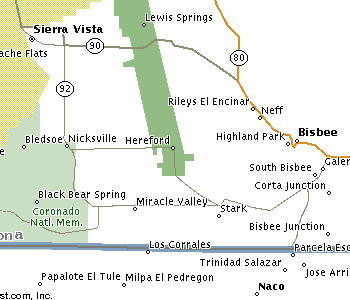 LM:
LM:
Describe the area where you live, is it very rural?
Henry:
We live about eight-ten miles north of the border. We formerly lived in rural Cochise County, but about 5 years ago, we moved into the city limits of Sierra Vista. We retain a close relationship to many ranchers in the county, where most have sustained enormous property damage from the invasion and extensive environmental damage as well. We try to assist them as often as we can, although our main effort now is to detect alien entry points, disrupt, and prevent the flow of illegals in the western part of the county
LM:
How long have you lived in Cochise County and what do you do for a living?
Henry:
We have lived in the county for nine years. Kathy and I are both retired refugees from California. Kathy is a retired school teacher and I am retired from law enforcement and was a city manager.
LM:
You mentioned your wife, Kathy. Is she involved with border watching as well?
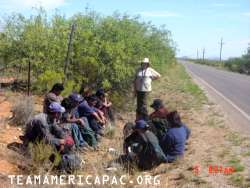 Henry:
Henry:
Here is a picture of Kathy watching a group of illegal aliens we encountered on a friend's ranch while awaiting the Border Patrol.
We took this photo last summer in August 2003. We (Kathy and about 6 friends) were monitoring a well-used human smuggling trail about 5 miles west of Naco, Arizona and about 1.2 miles north of the border.
The area is a spider web of smuggling trails and was largely ignored by the Border Patrol. It was common to encounter 40-50 illegal aliens per night, which the Border Patrol would collect as we called the groups in.
 This picture is just a typical event and I decided to take Kathy's picture. Why do my wife and other elderly women have to be out in the wilderness late at night defending this country from an illegal invasion? This is the constitutional duty of the Federal Government.
This picture is just a typical event and I decided to take Kathy's picture. Why do my wife and other elderly women have to be out in the wilderness late at night defending this country from an illegal invasion? This is the constitutional duty of the Federal Government.
LM:
How do you make them stay put until the Border Patrol arrives? The photo shows several of them are just sitting quietly on the ground while your wife Kathy is watching over them. Why didn't they just run away from you?
Henry:
All the illegals know that they are breaking the law and know the consequences of such law breaking in Mexico. When encountered by American citizens, particularly in areas that they do not expect it, most are shaken and realize that they have been discovered. We ask if they are Mexicans and if they are "Mojados." *
Then, we ask them to sit down, and tell them that the Border Patrol will be along shortly to collect them. They seem to realize at that time that there is no escape.
When an encounter occurs, many times the Coyote (smuggler) runs and escapes leaving the group stranded. They don't know where they are, except that they are in a wilderness, they don't know their destination or how to find the pickup point, so in those cases it becomes more of a rescue than anything else and particularly if there are children in the party.
However, many times groups don't stop and they run off. We do not try to detain anyone through forcible means because we know that the Mexican Consul would agitate to have us charged and arrested, even though the aliens are the lawbreakers. There are many alien advocacy groups and organizations promoting illegal immigration, which would sue us if given the opportunity. We don't want the aggravation of going through any of this therefore we are very careful not to step over the line.
You wrote the phrase "until the Border Patrol arrives" which begs the question, why wasn't the Border Patrol there to begin with, since some of the locations we use are high alien traffic areas?
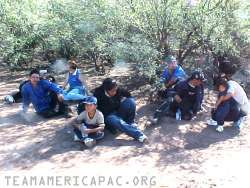 LM:
LM:
Give me another example of what you see while guarding our border.
Henry:
Early one morning recently, several citizens were watching a well-used smugglers trail. We were about a half-mile north and about one mile east of the San Pedro River. The Border Patrol generally ignores the trail, even though it is a high traffic area.
Smugglers transport illegal aliens from Naco, west to this area about five miles from town, and then bring them into the area north from Cananea.
This group came walking down the trail quite unaware that there were citizens in the area.
You will note that these illegals are not of the "poor, starving" variety which the media often portrays the invaders, but are obviously very middle class, and their appearance is like that of those in any U.S. city. They just decided to crash the border and steal the "good life".
You will also note that while out in a wilderness area they are not carrying supplies or extra clothing. They have a small supply of water, and have several small children with them.
That probably indicates that they had a quick pickup scheduled and would not have to travel far on foot. Highway 92 is about 2 miles north of this location. They didn't make it in that day.
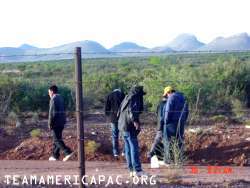 LM:
LM:
What's going on in this photo?
Henry:
A few days ago, I was on the border all night with some neighbors filming with a thermal camera the activities of aliens crossing the border. After dawn, while we were driving the border road west of Naco, we encountered a small group of young Mexicans waiting to cross the fence and enter the country illegally.
After we passed by, they crossed over. We had been on the border from about dusk until dawn and had not seen any Border Patrol guarding the area -- and certainly not in the area of this encounter.
LM:
Does the Border Patrol have a quick response time to your calls?
Henry:
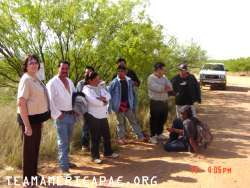
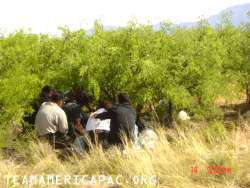
It took the border patrol 1.5 hours to respond. The Naco station is only about 20 miles from this site but agents are in or around this area all the time.
LM:
Are drugs going through this area as well?
Henry:
In addition to people smuggling, Cochise County is the most extensively used land route for drug smugglers in the country. Drugs come in and through by car, truck, and van. In addition, a significant effort to transport drugs overland into the county by people carrying the drugs on their bodies similar to that of pack animals.
Smugglers carrying drugs overland are referred to as "Mules".
There are many routes used by Mules through Cochise County, but one of the routes most used is through the Huachuca Mountains, down washes into flatland and to an appointed drop site or pickup site.
The attached photos are of a drop site about 25 miles north of the border and about 5 miles east of the mountains. The site is easily accessible by utility roads through the desert and is adjacent to a highway for quick transfer and escape with the goodies.
LM:
Do you have children, and what has impact has illegal immigration had upon them and your family?
Henry:
We have five grown children and two of them still live in California. The impacts on their lives are higher taxes to pay for free services to illegals whether they want to or not, and overcrowding with the press of uncontrolled population growth of which a main contributor is illegal residents.
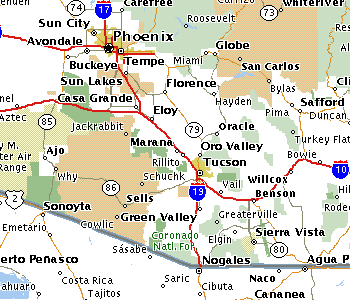 LM:
LM:
Do you take any special precautions to protect your family and home?
Henry:
We always take defensive precautions no matter where we are in the county. When we are guarding the borders we always take extra precautions in case we must deal with violence and have to defend ourselves. Both Kathy and I are licensed to carry concealed weapons as are many of our associates and we are trained in self-defense.
LM:
What about your neighbors. Are many of them concerned?
Henry:
Most city folks are not that concerned with the illegals because they don't observe the invasion first hand. Like many other people across America they receive limited news about the invasion by media sources. That is unless they have to go to the hospital emergency room or use other services that are filled to capacity by the illegal aliens - then we see the complaint letters and calls in to local talk shows.
LM:
If the problem of illegal immigration was solved, what would be the best part about living in your area?
Henry:
Enjoying the pristine beauty of the area. Not long ago our desert and mountain areas were the most beautiful places on earth. Today alien garbage trails and dangerous invaders contaminate them. The average trash load in our county from illegal aliens is about 8 pounds per illegal passing through the county. Multiply that by 5-10,000 illegals per day and one can begin to see the magnitude of our problem.
 We took this photo recently about .8 mi north of the Mexican border and about .5 mi east of the San Pedro River in southern Cochise County Arizona. The aliens were just strolling into the U. S.
We took this photo recently about .8 mi north of the Mexican border and about .5 mi east of the San Pedro River in southern Cochise County Arizona. The aliens were just strolling into the U. S.
LM:
Looking at the photos I can't help but feeling sad for some of the aliens. Do you find yourself feeling the same way?
Henry:
We are sad that they are foolish enough to put their lives in danger and inflict extreme hardship on themselves by trying to break into our country. Yet, we are angry that they think that they have a right to come here and tear down our American way of life. Their loyalty remains with their homeland, so they completely disregard what Americans have invested to create and maintain our wonderful country. They do not want to join our society to become Americanized, instead they are, and plan to remain Mexican.
LM:
Thank you Henry for helping me to present your story to the American people.
Henry:
It is my pleasure to work with you on this, any time we can get someone to listen and present the reality of what is happening on our borders, we are very grateful. Please feel free to call, e-mail or otherwise any time you wish.
* Mojados means "wet back", a term Mexicans adopted to define an illegal alien. It was coined decades ago when most of the illegals crossed the Rio Grand river to enter the country. It is a term widely used on both sides of the border.
|


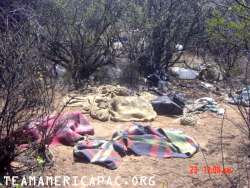
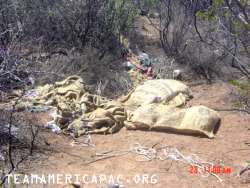
 LM:
LM:
 LM:
LM: Henry:
Henry: This picture is just a typical event and I decided to take Kathy's picture. Why do my wife and other elderly women have to be out in the wilderness late at night defending this country from an illegal invasion? This is the constitutional duty of the Federal Government.
This picture is just a typical event and I decided to take Kathy's picture. Why do my wife and other elderly women have to be out in the wilderness late at night defending this country from an illegal invasion? This is the constitutional duty of the Federal Government.
 LM:
LM:  LM:
LM: We took this photo recently about .8 mi north of the Mexican border and about .5 mi east of the San Pedro River in southern Cochise County Arizona. The aliens were just strolling into the U. S.
We took this photo recently about .8 mi north of the Mexican border and about .5 mi east of the San Pedro River in southern Cochise County Arizona. The aliens were just strolling into the U. S.